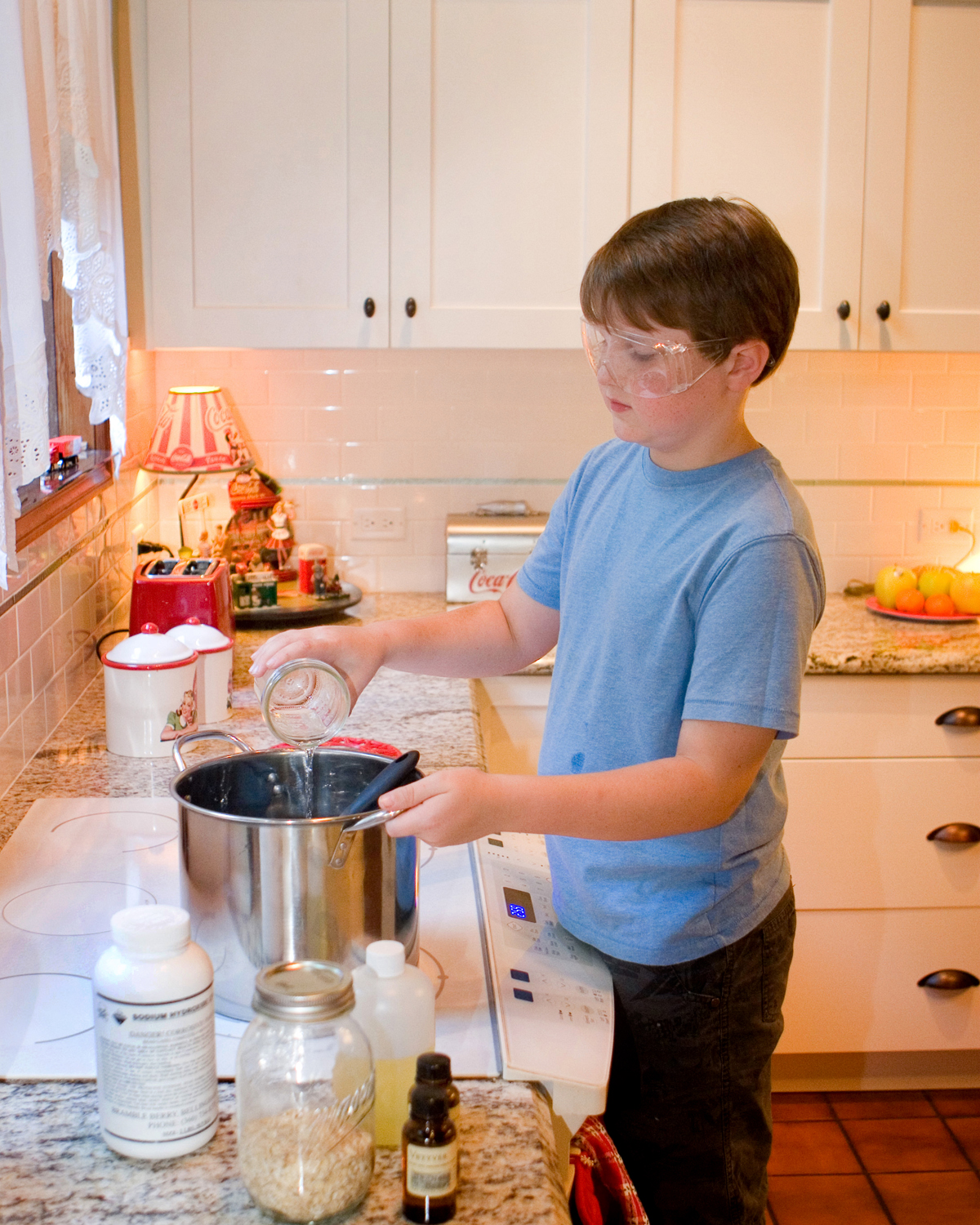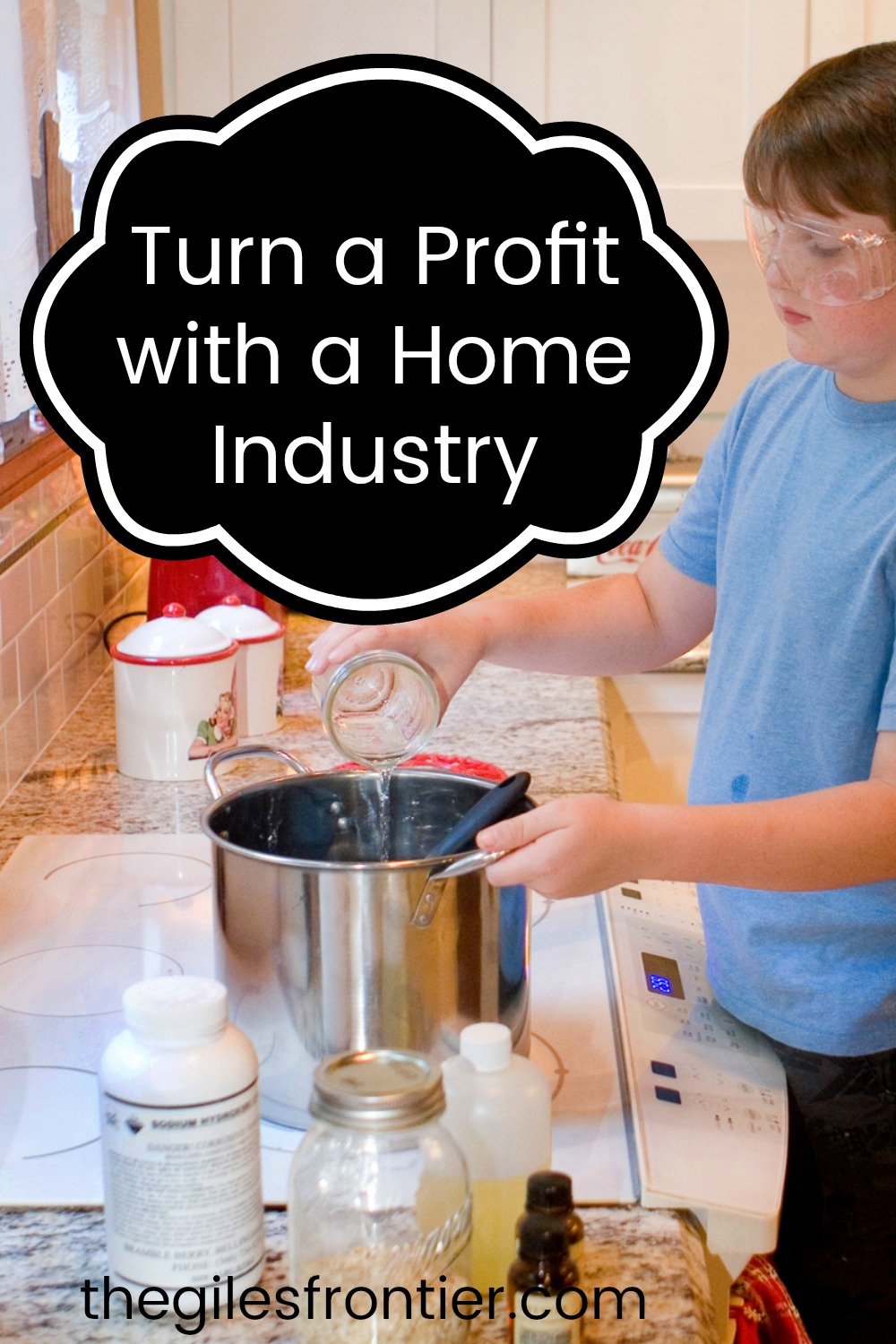
As an Amazon Associate, I may earn commissions from qualifying purchases from Amazon.com
Homeschool Science Experiment
A family industry can take shape when you least expect it, producing income and valuable lessons for children. I want to share with you how a homeschool science experiment can sometimes yield viable products, even when you weren’t trying!
Science and history are our two favorite subjects in our homeschool classroom because of all the boy crafting that happens in our house. Recently, my son, Grant, and I were reading about the early days of soap making. We discussed the story my grandmother had shared about making lye soap at her grandmother’s farm in Alabama.
Early Methods of soap making
My grandmother’s family would soak wood ashes to create the lye, then mix it with lard to form the bars of soap the whole family would use for the following year. She explained how nothing went to waste and said that most of the time, the water they used for soaking the ashes was dirty dishwater from the kitchen!
After reading our history book and watching a pioneer family video on soap making, my creativity started to flow. Why don’t we make our own soap for homeschool science! Fortunately for me, my boys are game for anything. So after a little research, I ordered supplies to begin our overlapping lessons in science and history. (Thankfully, modern-day technology makes it possible to buy lye in flakes for soap making instead of soaking wood ash from our backyard fire pit.)
Modern Methods of soap making
I had a two-fold plan for this homeschool science experiment. We would learn the science of soap making by mixing lye with water, oil, and our own additives to create a hard bar of soap that we could actually use. I hoped we would also discover and discuss the exact ingredients of our soap and apply the knowledge to Grant, who suffers from a lot of skin allergies.

How to make lye soap
Following all the directions in soap making is essential unless you want to end up with a stockpot full of goo. Safety is also paramount when working with lye. Grayson and Grant chose to add ground oatmeal, cinnamon, cloves, and vetiver oil. After mixing, the soap had to sit and harden for three weeks.
It looked like dirt, which I found fitting for two boys who stay dirty most of the time.
Taking it one step further would be fun, and having the boys give their soap a name and create a label. It would be a perfect Christmas gift for friends and family. True to their personalities, they settled on “Dirty Boy Soap”. To top off the name, Grayson and Grant went out to the lake and decided to surprise me with a photo opportunity.
Mud. Lots of mud. Our new product label was born.
The Product
That Christmas, we gave our soap as gifts and were overwhelmed by the positive response. We hadn’t expected everyone to love Dirty Boy Soap. While the soap itself was great, it proved to be the name and packaging that was so attractive. It was such a novelty that friends asked if they could purchase some to give as gifts. I wondered if we were on to an idea with greater potential.
We took a basket of our soap to a craft show where we were already selling our feed sacks. I did not think we would sell much if any. The boys were proud to have their soap creations on display. But by the end of the craft show day, all of the soap was gone. Most people bought it as a gift for someone with boys of their own. It had always been a joke in our house that the boys never want to bathe.
I think it is a universal phenomenon in households with boys that they don’t like to bathe. Perhaps having a soap that looks like dirt and dirty boys on the label makes taking a bath a bit more fun? At any rate, Grayson and Grant were thrilled that their soap was a hit!
So then, how can you apply a homeschool science experiment to make a profit?
Ask these questions
- Is there an interest that your children go back to again and again?
- Does your family enjoy a particular subject from which you could create a product?
- Have you already done an experiment that produced an unusual item of interest?
- Is there something you have wanted to try but have not done so yet?
You don’t need to have more than one product to be successful. We have been making the same soap for two years. We have repeat customers and keep extra on hand for new orders. Making a new kind of soap might be successful but, for us, Dirty Boy Soap has been a winner. The boys also make a flower press that has become popular on ETSY.
I recommend you choose something fun for your family to make. Still, you can incorporate educational lessons in history, business, science, or something else to glean the most reward. Use birthdays and holidays to share your new product with family and friends. They may be your best customers in the future.
Tips for a homeschool science experiment and home industry:
- High schoolers can record hours and apply it toward credit in the course of study.
- Find a category your product fits into and make it a unit study. It may be related to history, engineering, technology, business, etc., or even multiple subjects.
- Incorporate literature by reading books on the subject. Storybooks and instructional manuals offer a broad range of learning.
- Teach a group of children or a co-op class how to make your product or a version of it.
- Incorporate writing and literature with a story of how you came up with your product.
- Write detailed instructions on how to make your product. Some children prefer technical writing over creative writing.
Over the years, our family has ventured into several ideas that have produced extra income. We have learned how to embrace ideas that might be unusual and turned them into experiences that have positively impacted our home education.
Using opportunities beyond traditional school books can create an educational experience and bonus income for the whole family. Look at your lifestyle and your family’s activities to see if a new income opportunity is as close as your kitchen sink.
